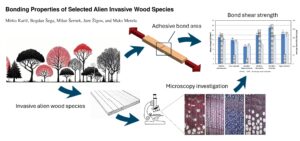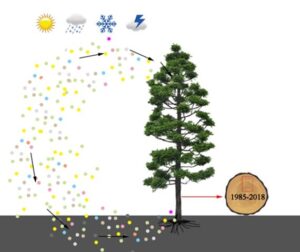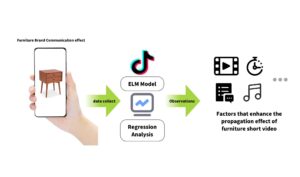Volume 19 Issue 2
Latest articles
- Researchpp 3078-3094Kariž, M., Šega, B., Šernek, M., Žigon, J., and Merela, M. (2024). “Bonding properties of selected alien invasive wood species,” BioResources 19(2), 3078-3094.AbstractArticlePDF

Invasive alien plant species pose a significant challenge to European ecosystems. They displace native vegetation, damage agricultural land, and annually cost the European economy billions of euros. Many of them are removed daily and mainly burned, although some of them produce lignocellulosic material that could be used in place of native wood species. In this study, the bonding properties of selected invasive wood species in Slovenia were tested using standard methods. Wood lamellas were produced according to the SIST EN 205 standard from Ailanthus altissima, Aesculus hippocastanum, Robinia pseudoacacia, Gleditsia triacanthos and Acer negundo and glued with polyvinyl acetate (PVAc) and one-component polyurethane (PU) adhesive. The results showed that selected wood species can be bonded well with both adhesives (bond shear strengths from 7.2 to 15.1 N/mm2), although there were large variations due to the heterogeneity of the wood material. The differences in the shear strength of the bonds were mainly due to the different densities of the wood (479 to 702 kg/m3) species and the high variability in material properties (for example porosity from 0.54 to 0.68 and shear strength in tangential direction from 11.2 to 21.1 N/mm2), which are related to the anatomical characteristics of the individual wood species.
- Researchpp 3095-3105Im, W., Youn, H. J., and Lee. H. L. (2024). “Evaluation of print mottle of double coated paper by octave band filtering technique,” BioResources 19(2), 3095-3105.AbstractArticlePDF
The effects of the pre-coating color formulation, dwell time, and coat weights of pre- and top- coating layers on print mottle of double-coated paper were investigated using an octave band filtering image processing technique. To investigate the effect of pre-coating color formulations, six types of coating colors were used. Mottle index and coefficient of variance (COV) of double-coated paper increased as the size of pre-coating pigment particles decreased, which was attributed to the reduction in relative pore size of the pre-coating layer. Decreasing the dwell time decreased transfer time from the coating head to dryer of a Maiyoh coater. As the transfer time to dryer decreased, the mottle index and COV increased because of uneven distribution of latex within the coating layer. Pre-coat weight was found to have a greater impact on print mottle than the top-coat weight.
- Researchpp 3106-3120Govindarajan, P. R., Shanmugavel, R., Palanisamy, S., Khan, T., and Ahmed, O. S. (2024). “Crash-worthiness analysis of hollow hybrid structural tube by aluminum with basalt-bamboo hybrid fiber laminates by roll wrapping method,” BioResources 19(2), 3106-3120.AbstractArticlePDF
Hollow hybrid structural tubes were evaluated using commercial-grade Diamond Micro Expanded Mesh (DMEM) thin mesh of aluminum (Al) as structural reinforcement. Axial, transverse (flexural), and radial compression tests were performed on four different layered hybrid structures using bamboo (Bm) and basalt (B). With a maximum force of 34.7 kN, compressive ultimate strength of 238 MPa, and strain of 12.6%, AlBmB (with layers labeled from inside to outside) was the best performer in the axial compression test. AlBmB’s adaptability was demonstrated by the flexural test, showing a maximum bending force of 4.7 kN, a flexural strength of 97.7 MPa, and a decreased deflection of 13.2 mm. Radial compression test results underscored the superior energy absorption characteristics of AlBmB. The varying material interfaces in the hybrid tubes yielded distinctive performances. AlBmB, incorporating bamboo and basalt layers, stood out with superior energy absorption and crush force characteristics, indicating enhanced crashworthiness. The other hybrids AlBm, AlB, and BmB also exhibited commendable performances, emphasizing the adaptability of different material combinations. The meticulous selection of DMEM and innovative roll wrapping method for fabrication reliably influenced the tubes’ mechanical properties. The study contributes to advancing the design of lightweight, durable, and high-strength components.
- Researchpp 3121-3137Dias, A. M. P. G., Machado, J. S., Mascarenhas, F. J. R., Morgado, T. F. M., Pedrosa, N. G., Carneiro, L. C. P., and Marques, A. F. S. (2024). “Reuse of wooden utility poles through the combination of new and old elements,” BioResources 19(2), 3121-3137.AbstractArticlePDF
Wooden utility poles are crucial in supporting overhead telecommunication lines in Portugal. Maritime pine (Pinus pinaster Aiton) is the most common wood species used for this purpose. The durability of the poles is typically determined by the deterioration observed in their ground line. Aiming to reduce the use of new sound wooden poles, reducing the economic costs involved, and the environmental impacts, the reuse of those old wooden poles by removing the degraded part is one possible solution. This study aimed to develop and validate solutions with composed poles, specifically for the connections between the wood members, so that it is possible to more efficiently incorporate used parts into the remanufactured poles. Two types of connections were used: members joined by a cylindrical steel tube, and members joined by finger joints. The static bending moduli of elastic and rupture were tested. The mechanical properties of the reused wooden utility poles showed to be in line with the values of new sound wooden poles made of different wood species. Finally, both proposed solutions proved to be practical for use in the production of reused utility poles, which are mostly made from old timber poles.
- Researchpp 3138-3148Gunes, M., Ersin, C., and Altunok, M. (2024). “Effect of climate and wood type on elastic modulus of heat-treated wood and its optimization by the Taguchi method,” BioResources 19(2), 3138-3148.AbstractArticlePDF
Wood, as the oldest building material, provides some of the basic needs of human beings, including shelter and protection. Wood is used in exterior cladding, carrier systems, joinery, ceiling-floor coverings, windows, doors, and furniture production. When wooden material is exposed to external weather conditions, due to its hygroscopic structure, its physical and mechanical properties deteriorate from exposure to moisture, temperature, and biological organisms. The bending modulus of elasticity of Scots pine (Pinus sylvestris L.), oak (Quercus petraea L.), and chestnut (Castanea sativa M.) wood that was tannin-impregnated and heat-treated at 160 °C, was investigated using Taguchi L9 (33). The sequence was optimized. After heat treatment, the carrier elements were subjected to artificial climate conditions. In the optimization of the data obtained, it was understood that the highest impact factor was the tree type. In contrast, the climate on the elastic modulus was the lowest impact factor. In Taguchi analysis, a mathematical prediction model was created using actual and predicted data using the S/N ratio’s biggest-best equation. The R2 of the model can be predicted with an accuracy rate of 98.6%.
- Researchpp 3149-3163Gu, X., Xu, Q., Mwamba, B., Wang, Z., Qi, L., Wang, J., Song, L., and Wu, J. (2024). “Flexural vibration test method for determining the dynamic elastic modulus of full-size strawboards for use in transportation framed cases,” BioResources 19(2), 3149-3163.AbstractArticlePDF
This paper proposes an improvement in the test method for determining the flexural dynamic modulus of elasticity of strawboard with two triangular prisms as supports, for quality control and classification. Free-plate modal and free-plate transient excitation methods were used to test the elastic modulus of 1/4-plate and whole-plate strawboards. The dynamic test results were verified with the four-point bending method and tensile method. The results show that the elastic moduli of strawboards is approximately 2 GPa. The dynamic test method proposed is efficient, simple, repeatable, and accurate. This method is more suitable for factory applications than existing dynamic testing methods. The framed cases produced by the strawboard all meet the performance requirements in GB/T 7284 (2016).
- Researchpp 3164-3179Li, Z., Wang, T., Liu, S., Yang, Y., Yang, L., Yu, C., Wang, G., Hui, Y., Li, Z., and Li, X. (2024). “Climate-affected multi-decadal variations of biogenic volatile organic compounds in Pinus tabuliformis growth rings,” BioResources 19(2), 3164-3179.AbstractArticlePDF
 Long-term dynamics of biogenic volatile organic compounds (BVOCs) in trees are rarely reported, despite environmental factors (such as climate change) influencing their growth and the subsequent chemical accumulation. For this, tree growth rings provide a promising biological proxy for the long-time variation and correlation with environmental changes. Therefore, tree rings from Pinus tabuliformis (two stem disks and 40 tree cores) were collected in the Taihang Mountain Macaque National Nature Reserve of China. These samples were divided into seven 5-year resolutions over the 34-year period 1985 to 2018. This enabled analysis of multi-decadal variations of compounds and their correlation with climate variability. A total of 292 BVOCs were detected; however, only 18 compounds were found together across all the 7 growth-periods. Temporal analyses showed decreasing trends for monoterpenes (0.026%/yr) and diterpenes (0.120%/yr), whereas alcohols and oxygenated monoterpenes showed increasing trends at 0.031%/yr and 0.042%/yr, respectively. Correlation analyses showed no obvious link to yearly precipitation, while seasonal temperature had a negative effect on monoterpenes and diterpenes but positive effects on alcohols and oxygenated monoterpenes (all P < 0.05). The present study showed that dendrochronology is a suitable method for re-establishing the biological effects from historical climate variability on key tree species.
Long-term dynamics of biogenic volatile organic compounds (BVOCs) in trees are rarely reported, despite environmental factors (such as climate change) influencing their growth and the subsequent chemical accumulation. For this, tree growth rings provide a promising biological proxy for the long-time variation and correlation with environmental changes. Therefore, tree rings from Pinus tabuliformis (two stem disks and 40 tree cores) were collected in the Taihang Mountain Macaque National Nature Reserve of China. These samples were divided into seven 5-year resolutions over the 34-year period 1985 to 2018. This enabled analysis of multi-decadal variations of compounds and their correlation with climate variability. A total of 292 BVOCs were detected; however, only 18 compounds were found together across all the 7 growth-periods. Temporal analyses showed decreasing trends for monoterpenes (0.026%/yr) and diterpenes (0.120%/yr), whereas alcohols and oxygenated monoterpenes showed increasing trends at 0.031%/yr and 0.042%/yr, respectively. Correlation analyses showed no obvious link to yearly precipitation, while seasonal temperature had a negative effect on monoterpenes and diterpenes but positive effects on alcohols and oxygenated monoterpenes (all P < 0.05). The present study showed that dendrochronology is a suitable method for re-establishing the biological effects from historical climate variability on key tree species. - Researchpp 3180-3190Tascioglu, C., Yoshimura, T., and Ohmura, W. (2024). “Durability ratings of post-treated wood-based composites after 14 years of field exposure,” BioResources 19(2), 3180-3190.AbstractArticlePDF
Several commercial wood-based composites (softwood plywood [SWP], hardwood plywood [HWP], medium-density fiberboard [MDF], oriented strand board [OSB], and particleboard) [PB]) were post-treated with alkaline copper quat and copper azole at two different retention levels. The treated specimens were installed on concrete blocks covered with 5-sided PVC boxes simulating the crawl space conditions (protected above-ground) in Japanese houses in Southern Japan where decay and termite activity are high. The experimental variables are a comparison of treated versus untreated, preservative type and retention levels. During 14 years of exposure, the specimens were biannually visually rated. In general, termite damage became visible earlier and the harshness of attack was higher when compared to decay damage. The untreated and treated MDFs were the most resistant under the protected above ground conditions at the end of 14 years exposure. Particleboard durability performance followed the MDF rating during the same period. The untreated OSB, HWP, and SWP were the least resistant composite types. The treatments substantially increased the durability of the mentioned composite types by 317.6%, 80.5%, and 133% higher termite grading when correlated to their untreated controls, respectfully, yet they failed to maintain full protection. Based on statistical analysis, preservative types and retention levels did not significantly affect decay and termite ratings.
- Researchpp 3191-3207Yu, S., and Wu, Z. (2024). “Research on the influence mechanism of short video communication effect of furniture brand: Based on ELM model and regression analysis,” BioResources 19(2), 3191-3207.AbstractArticlePDF

The elaboration likelihood model (ELM) and regression analysis were used to investigate the impact of furniture brands’ communication strategies on consumer behavior through short video platforms. The work examined a set of representative short videos, analyzing how key features—such as content theme, duration (16-60 seconds), graphics, subtitles, background music, and title style—affected communication effectiveness. The ELM model uncovered the correlation between these video characteristics and the Communication Effect Index (DCI), with statistical significance confirmed by regression. Findings indicated that live broadcasts, graphical presentations, subtitles/topics, upbeat music, and exclamatory titles significantly enhanced communication efficiency. Limitations, including time-period sampling bias, sample size, and item duplication in the ELM application, were also considered. Based on these findings, the research offers optimization suggestions and future directions for furniture enterprises in leveraging short video marketing.
- Researchpp 3208-3233Kucuk, S. D., Groso, A., Collet, G., Daniellou, R., and Caliskan, U. K. (2024). “Effect of bacterial nanocellulose and plant-containing facial serum on hyperpigmentation in in-vitro conditions,” BioResources 19(2), 3208-3233.AbstractArticlePDF
This study investigated the effect of some herbal extracts, such as licorice root, white mulberry leaf, green tea leaf, and grape seed, with a combination of bacterial nanocellulose and some bioactive materials, such as ascorbic acid, niacinamide, hexylresorcinol, and alpha-arbutin, on treatment of hyperpigmentation. The effect of the prepared emulsions on hyperpigmentation was revealed by analyzing their tyrosinase inhibition properties, their ability to stop melanin production, or their properties of whitening the brown spot on the skin. In addition to the physicochemical properties of the 5 different emulsions obtained, tyrosinase, collagenase, and elastase enzyme activities, antioxidant properties, cytotoxicity, and microbiological analyzes were performed by cell-culture modelling. Finally, a dermocosmetic facial serum was designed that is compatible with skin pH, is homogeneously mixed, has good spreading properties, does not cause any microbiological growth, does not inhibit elastase activity while stimulating collagenase activity, reduces melanin production by inhibiting the tyrosinase enzyme, and does not have any toxic effects.
